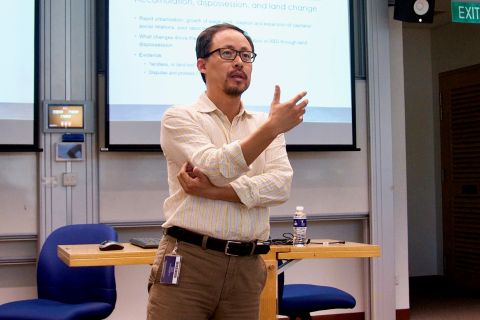
By Rebecca Tan
SMU Office of Research & Tech Transfer – When it comes to measuring the health of the economy, the gross domestic product (GDP) and the level of unemployment are two closely watched indicators. Intuitively, a growing economy should experience a low level of unemployment, but this is not always the case.
Take the example of Turkey, which in 2017 saw its GDP grow by 7.4 percent, making it the second-fastest growing economy in the Organisation for Economic Cooperation and Development. Despite these seemingly healthy figures, unemployment data suggests that the picture is far from rosy – unemployment remained unchanged from 2016 to 2017 at 10.9 percent, while youth employment in fact grew from 19.2 to 24.5 percent.
“The economy is growing but it isn’t creating jobs, especially for the young. This situation in my home country of Turkey is a puzzling problem, driving my own interest in labour issues,” says Assistant Professor Ismail Baydur, who studies labour economics at the Singapore Management University (SMU) School of Economics.
What explains unemployment?
In particular, Professor Baydur is interested in negative duration dependence, the phenomenon whereby the longer a person stays unemployed, the harder it is for him to find a job. Although this phenomenon has been known for a long time, there is still no strong consensus on the reasons for this behaviour, he says.
Two main explanations have been proposed. First, it could be that the longer a person spends unemployed, the more he loses his job-related skills and career-related network, a factor called skill deterioration.
Second, a long period of unemployment could also signal to potential employers that the job seeker is not a good candidate, negatively influencing their chances of finding work. This behaviour of individual firms is called statistical discrimination, in this case referring to discrimination against a particular group of people based on stereotypes about that group.
“For example, when firms receive two CVs that are essentially the same, except that one candidate has been unemployed for a period, they might on that basis discriminate against the person who has been unemployed for a longer duration,” Professor Baydur says.
Dealing with discrimination
The problem for economists like Professor Baydur is figuring out which of these factors is at play under different circumstances. To answer this question, Professor Baydur and his colleague Assistant Professor Xu Jianhuan, also of the SMU School of Economics, developed a model that incorporated both factors and tested it against empirical data from the US Current Population Survey, a monthly employment survey of about 60,000 households.
“Statistical discrimination is going to depend on the state of the economy,” explains Professor Baydur. “If the economy is bad, not many can find a job, so employers will not downgrade a CV harshly if they see employment gaps.”
On the other hand, if skill deterioration is the main reason for unemployment, people will remain unemployed no matter the state of the economy, he continues. Whether the economy is in recession or experiencing growth, people in the unemployment pool will continue to lose their skills and networks.
“We built both of these features into a model and let the data tell us which one is stronger,” Professor Baydur says. “What we found was that statistical discrimination has a very strong effect. In fact, if we could remove statistical discrimination from the picture, the job finding rate increases by 40 percent for someone who is six months unemployed.”
How to help the unemployed
These findings suggest that policies targeting statistical discrimination could help reduce unemployment, Professor Baydur adds, pointing to the Hiring Incentives to Restore Employment (HIRE) Act in the US, implemented to counter the effects of the 2009 Great Recession, as an example. Under the HIRE Act, the US government encouraged the hiring of people who had been unemployed for at least 60 days by subsidising their social security premiums.
However, the situation is different for the long-term unemployed, defined as people who are unemployed for longer than 18 months. In these cases, the model shows that removing the impact of statistical discrimination does not increase the job finding rate unless skill deterioration is also removed.
“The conclusion that comes out of our research is that if the concern is about the long-term unemployed, then both statistical discrimination and skills deterioration are important, and policy should focus on both factors,” Professor Baydur says.
Shaping employment policy
Adding similar nuance to broad sweeping policy is a study by Professor Baydur published in the American Economic Journal: Macroeconomics, which showed that hiring subsidies are more effective than previously thought. Titled ‘Worker Selection, Hiring, and Vacancies’, the study showed that once the growth rates of different companies are taken into account, hiring subsidies are about three times more effective at reducing the unemployment rate as compared to predictions from standard labour market models.
Currently, Professor Baydur is working on extending his statistical discrimination and skill deterioration model and preparing it for publication. The current model is based on 484,416 observations spanning twenty years from 1996 to 2016; Professor Baydur is now extending the model by incorporating data that goes back to 1976. He is also planning to explore how different occupations and industries change over time, especially in response to the growing adoption of artificial intelligence and automation.
“Whether it is in the short term with unemployment benefits or employment insurance, or in the long term with training subsidies, I hope that my research can help to shape government policy related to the labour market,” Professor Baydur concludes.
Back to Research@SMU Issue 58
See More News
Want to see more of SMU Research?
Sign up for Research@SMU e-newslettter to know more about our research and research-related events!
If you would like to remove yourself from all our mailing list, please visit https://eservices.smu.edu.sg/internet/DNC/Default.aspx

